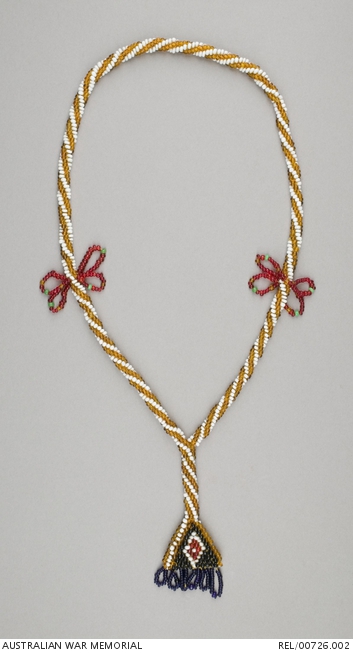| Place | Africa: Egypt |
|---|---|
| Accession Number | REL/00726.002 |
| Collection type | Heraldry |
| Object type | Heraldry |
| Physical description | Cotton, Glass |
| Maker |
Unknown |
| Date made | c 1915 - 1919 |
| Conflict |
First World War, 1914-1918 |
Turkish Prisoner of War beadwork necklace : Lance Corporal E Harris, 8 Light Horse Regiment AIF

Bead crochet necklace made from small white and gold beads fashioned in a spiral pattern. Red beaded fringing dangles half way up the necklace on each side with green and gold highlight beads. A triangular pendant with a dark blue bead fringe on the lower edge is attached to the necklace. It is beaded with black, white, red and gold in a diamond pattern.
Associated with the service of 965 Lance Corporal Edward Harris. Harris enlisted on 11 February 1915. He embarked from Melbourne on board HMAT Uganda on 21 June 1915 with 8 Light Horse Regiment and served on Gallipoli from September to early December 1915, before being admitted to 1 Australian Light Horse Field Ambulance with trench feet. Ten days later he was transferred to the Hospital Ship Oxfordshire with frost bite. He served with Depot stores in Cairo and Ghezireh in 1916 and 1917. Harris returned to 8 Light Horse in August 1917, serving in Palestine until the end of the war apart from two periods in hospital in Egypt and Gaza, the latter for malaria contracted in the summer of 1918. He was appointed lance corporal on 9 May 1919. On 3 July he left for Australia on board HT Malta. This necklace was made by an Ottoman prisoner of war (POW) in a British POW camp, probably in Egypt. Except for fatigue duties, prisoners were generally not required to work. Making craft items, along with playing sport, games or music helped them pass the time. The prisoners also made these items as a way of making some money to buy extra rations and supplies, such as coffee or tobacco; to barter with other prisoners; or as gifts for friends or family. The bulk of the Memorial’s beadwork collection comes from Egypt but there were also prison camps in England, Salonika, Cyprus, Mesopotamia, India and France where prisoners made similar souvenirs. To make them beads had to be strung in order of the design before crocheting commenced. Some of the smaller beaded crochet items could be made with all the beads strung at once. This necklace was made using single stitch beaded crochet.
Related information
Conflicts
Places
Subjects
Related Objects
- Turkish Prisoner of War beadwork snake : Lance Corporal E Harris, 8 Light Horse Regiment AIF
- Turkish Prisoner of War beadwork belt : Lance Corporal E Harris, 8 Light Horse Regiment AIF
- Beadwork pendant : Lance Corporal E Harris, 8 Light Horse Regiment AIF
- Beadwork choker or arm band : Lance Corporal E Harris, 8 Light Horse Regiment AIF